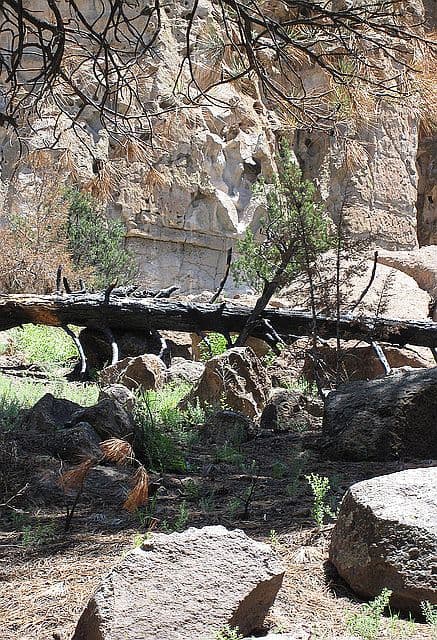 By Collin Haffey
By Collin Haffey
The Ecology Group at Bandelier National Monument has been monitoring tree growth on a weekly basis for more than 20 years.
Several trees located in Bandelier are ringed with dendrometer bands or dendrobands, for short.
A dendroband is a small ribbon of metal wrapped around the trunk of the tree and connected to a spring slide that moves as the tree grows and is measured by a Vernier scale. It’s basically a fancy ruler.
This scale enables us to measure a tree’s circumference down to a tenth of a millimeter.
The banded trees are located in three clusters that span the elevation range of ponderosa pine.
From the 20 plus years of data collection, we have learned a few things.
First, almost all of the trees start growing at about the same time – within a week or two – regardless of species, age or elevation.
Trees fluctuate in circumference, growing and shrinking, throughout the year.
This tells us the trees are swelling with recent precipitation and shrinking down when the soil dries out, but the overall trend is still up during the growing season. We suspect that the winter precipitation in the form of snow melt matters more to a tree from a growth stand point, but the monsoon rains do affect growth.
The trees at the higher elevation grow more in any given year than the trees at lower and mid elevations.
Even though we have been able to tease out certain trends from the data we still see a huge amount of variability within each year between the individual trees and between each year at each of the sites.
Not surprisingly during dry years, the trees don’t grow very much (ex: 2002, 2011) and years with above average winters (ex: 2010) trees grow a lot that next summer.
This long running study has been used in fire history research.
Since we know how trees grow on a weekly basis, we can assign a range of months to the different types of wood in the annual growth rings.
Trees grow fastest in the earliest part of the growing season, April to July; we can infer that a fire scar that is located in that position in the annual ring was created in spring or early summer.
Therefore, we can say with confidence that the vast majority (95 percent) of the historic fires in Jemez Mountains occurred during the spring.

